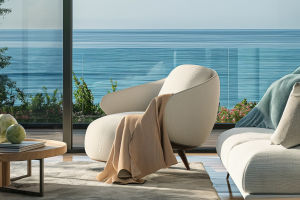Everyone knows that nothing feels quite as cozy and welcoming as a sofa in the living room. It's the heart of home comfort and everyday moments shared with loved ones. But beyond its comfort, Lykkers, the sofa is also a masterpiece of design and craftsmanship, especially in Europe.
Today, many leading manufacturers are committed to transforming sofas into more environmentally friendly products. This article explores how the industry is tackling the challenges of sustainability in upholstery, revealing exciting innovations and practical solutions.
The Challenge of Sustainability in Upholstery
Environmental Impact and Disposal Issues
Sofas present a unique sustainability challenge due to their complex construction and the difficulty of recycling them at the end of their lifecycle. Often, they end up as bulky waste in landfills or incinerators, as there are limited specialized recycling systems for upholstery.
This complexity arises from the mixture of materials used, including fabrics, foams, metals, and wood, which are not always easy to separate.
Key Features of Sustainable Sofas
A truly eco-friendly sofa needs to fulfill two main criteria: longevity and recyclability. It should be built to last for many years, reducing the need for replacement, and when its service life ends, it should be easily taken apart so individual components can be recycled or reused. This approach supports a circular economy where materials continuously flow back into production instead of becoming waste.
Innovative Approaches by Leading Brands
Circular Evaluation and Design for Disassembly
Cassina, a well-established company from Meda, has developed a tool called the Circular Tool, which measures how reusable, repairable, and recyclable each product is.
For over five years, Cassina and its partner brand Zanotta have worked with experts at a Milan technical university to apply sustainable design principles throughout their manufacturing processes. Their Mon-Cloud sofa, designed by Patricia Urquiola, can be disassembled almost entirely at the end of its use. This sofa reduces synthetic materials, favoring natural components derived from plants such as algae, agave, organic oils, and microorganisms.
Durability as Sustainability
B&B Italia, originating in Como, prides itself on innovation and longevity. An example of this is a sofa from the late 1960s that remains in excellent condition today.
The company recently reissued the Tufty-Time sofa, designed by Patricia Urquiola two decades ago, updating it with full disassembly features, recycled polyester covers without adhesives, and recyclable plastic parts. While consumer preferences often prioritize price, comfort, and style, these advances show how durability and recyclability are becoming important aspects of sustainability in upholstery.
Material Selection and Geographic Sourcing
Flexform, with a history dating back to 1959, chooses materials carefully, focusing not only on quality but also on proximity to reduce environmental impact from transport.
Their use of certified high-quality feathers ensures that natural materials are sourced responsibly and can biodegrade at the end of their lifecycle, even returning nutrients to the soil. The Loungescape seating system, designed by Antonio Citterio, reflects the company’s philosophy of blending domestic comfort with a deep connection to natural materials and aesthetics.
Expanding the Sustainability Concept
Continuous Material Innovation
Vitra, a design brand from Basel, treats sustainability as an ongoing process affecting everything from product development to raw material sourcing and supply chain organization.
Each year, new sustainable materials replace less eco-friendly ones. For instance, the Tip Ton chair, originally launched in 2008, is now available in fully recycled post-consumer materials. The Uten.Silo organizer, designed in 1969, has been updated to use only industrially recycled plastic.
Animal-Free Upholstery Options
Recent innovations include the development of cushion fillings made entirely from recycled fibers like PET and polyester, containing no animal-derived elements. This marks a significant step towards more ethical and environmentally conscious furniture production.
Conclusion: Towards a Greener Home Comfort
Sofas have always been a symbol of home life and relaxation, but now they are becoming a symbol of responsible design and environmental care.
Leading manufacturers demonstrate that creating durable, disassemblable, and recyclable sofas is possible, and that this approach can blend beautiful design with eco-conscious materials. While market awareness is still growing, these advances pave the way for more sustainable home furnishings that respect the planet.
For Lykkers who appreciate both style and sustainability, the future of upholstery looks bright — comfortable seating that cares for the environment as much as it does for those who use it. Embracing these innovations means choosing furniture that lasts longer, recycles better, and leaves a lighter footprint on the Earth.


